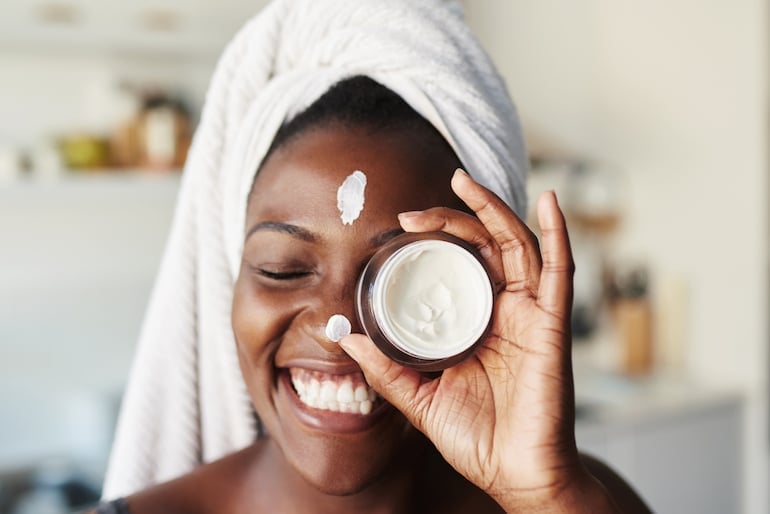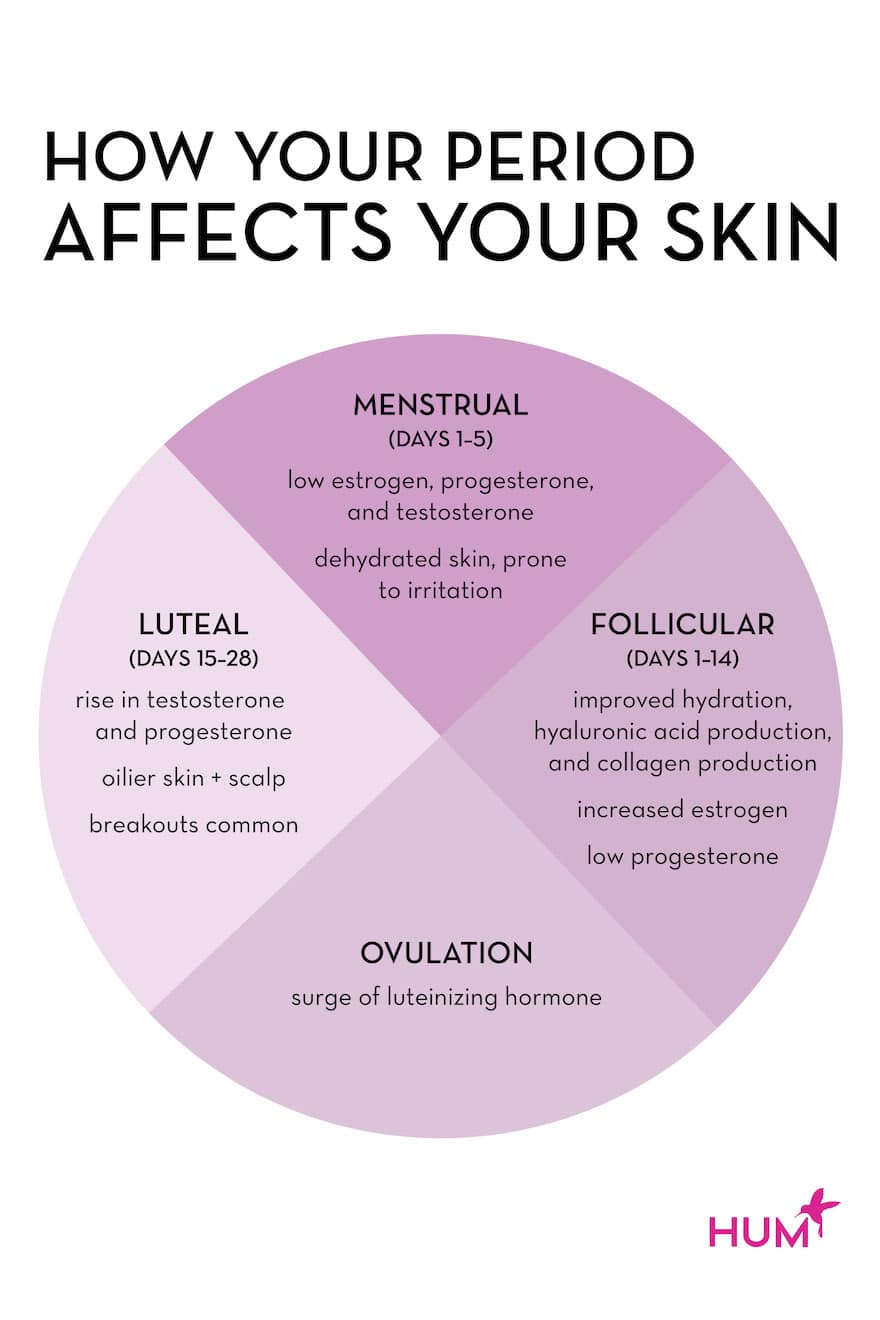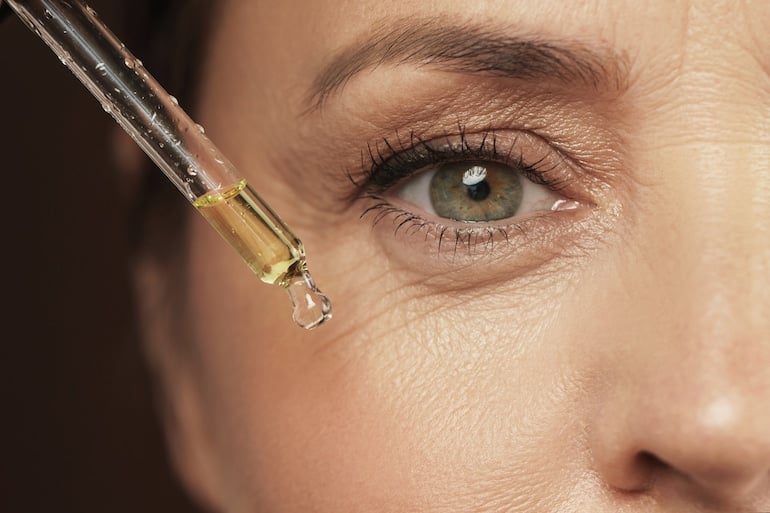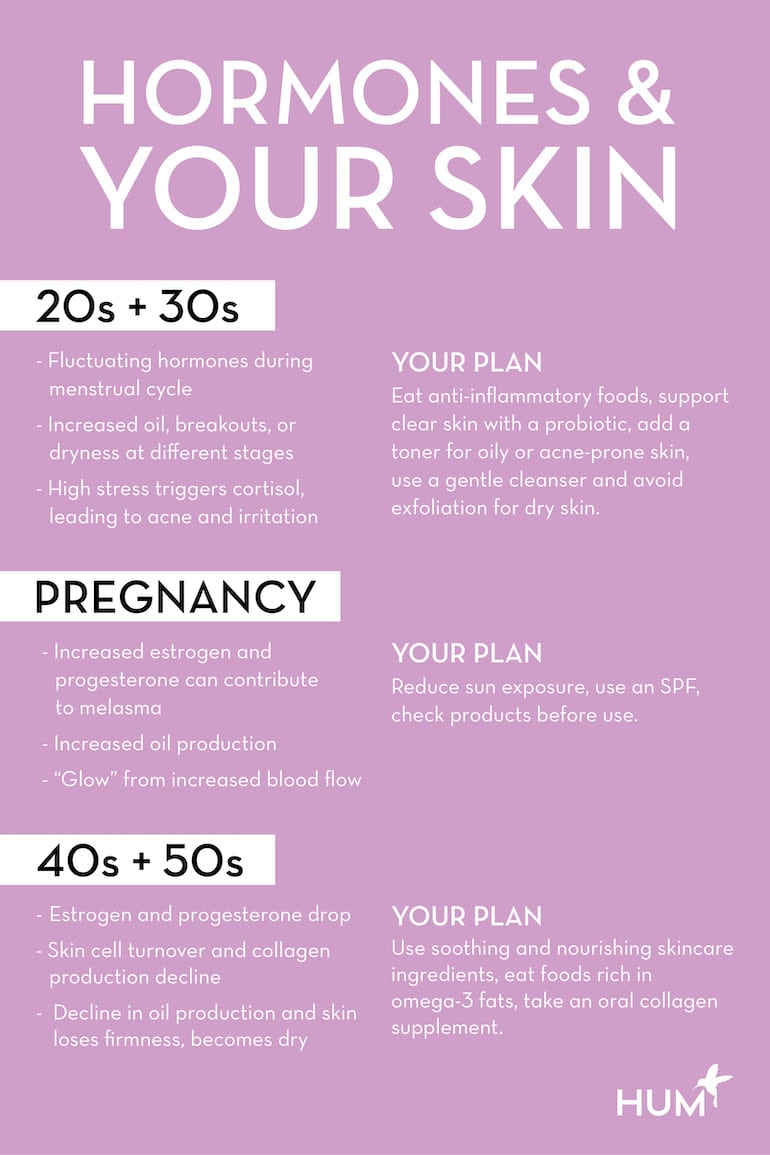What Hormones Cause Changes In Skin Hardness Or Dryness
How Hormones Impact Your Skin In Your 20s, 30s, 40s, And Across
When people talk well-nigh hormones, information technology's often in relation to how they touch on things like mood and energy levels, PMS symptoms, libido, and metabolism. But the truth is, these vital chemical messengers can have a profound event on your skin, as well. If you've ever dealt with hormonal acne you're probably well aware of this, but your changing hormone levels throughout life accept just as big of an effect.
The shift in sex hormones that occur as women age (and even throughout a single menstrual cycle!) tin can affect everything from sebum production, barrier part, collagen and hyaluronic acid production, and more.
The good news: Understanding how your short-term and long-term hormonal shifts influence your skin can aid you target your skincare routine and lifestyle habits to support optimal peel health and appearance. Below, we cover the hormonal shifts you can look to feel throughout your lifetime and simple, skillful-approved strategies to assist manage them.
The Key Players: How 3 Different Hormones Affect Pare

Earlier we dive into how hormones shift throughout a woman'southward life—and what that means for peel wellness—information technology'due south helpful to understand how specific sex hormones bear upon your skin. As with most other cells in your body, various types of cells within your skin take receptors for different hormones, and the presence or absence of these hormones can lead to different skin manifestations.
While non-sex hormones such equally cortisol (a stress hormone) can impact the pare, to an extent, we'll hone in on the ones that make the biggest difference: estrogen, progesterone, and androgens.
Estrogen
"Estrogen is key for the normal functioning of the pare besides every bit the blood vessels, hair follicles, oil glands, and our pigment-producing cells called melanocytes," says Keira Barr, Physician, a dual board-certified dermatologist and menopause specialist and author of The Skin Whisperer. "It is associated with collagen product, increased skin thickness, increased hyaluronic acrid product, improved skin bulwark function, maintaining skin hydration, reduced sebaceous (oil) gland action, and improved wound healing. Information technology also plays a role in modulating inflammation."
Progesterone
The consequence of progesterone on the skin is less well divers, only, according to Dr. Barr, it's thought to contribute to skin elasticity, pigmentation, and the increased apportionment and sebaceous gland activity that is observed in the second half of the menstrual cycle.
Androgens
Androgens, which are normally thought of as male hormones, can besides impact women's peel. These hormones, including testosterone, are produced in small amounts by the female person body and play a role in oil gland production. When hormones are imbalanced—as can occur in women with PCOS and when women experience insufficiently elevated androgen levels during menopause—androgens may also contribute to unwanted facial hair growth.
In your 20s and 30s

A lot can be going on in your 20s and 30s. Acne, which is often associated with adolescence, can still affect many women during this time menstruum, and it can accept a lot to do with the hormonal shifts that occur during womens' monthly cycles. In fact, research shows that about 50 percent of women in their 20s and 35 percent of women in their 30s experience acne.
Just in improver to periodic bouts of acne, skin can also vary in its moisture content, sensitivity, and general radiance depending on the time of the month. Here, nosotros break down the typical hormonal changes that occur throughout a menstruating woman's bike, how they affect skin, and what you lot can do most it:
Menses (days one-5)
Each menstrual cycle starts with menses, or your period. This takes place in the very outset of the follicular phase. "During this stage, levels of estrogen are at their lowest, which translates to a subtract in skin hydration and vulnerability of the skin bulwark to irritation and inflammation," says Dr. Barr. "With both progesterone and testosterone also low, in that location is less sebaceous gland activity and oil product, contributing to peel dryness."
Cumulatively, this can all add up to dehydrated skin that'southward more prone to irritation and inflammation. According to Dr. Barr, this is why conditions similar atopic dermatitis (eczema), contact dermatitis, and psoriasis, may be worse just earlier or during your period.
What you can exercise: Moisturizing with soothing and nourishing skincare ingredients is oftentimes your best bet. Opt for gentle cleansers and wait for things like hyaluronic acid, ceramides, gotu kola, and sea buckthorn oil on ingredient lists, suggests Dr. Barr. Scaling back on abrasive exfoliants and products containing too many active ingredients, including topical retinoids and chemic exfoliants, may besides help if y'all're decumbent to irritation. Finally, drinking plenty of water and eating foods rich in omega-3 fats, vitamin C, and antioxidants tin can help ease inflammation and irritation, back up a healthy skin barrier, and promote hydration from the within out.
Follicular stage (days one-14)
After your period, the residue of your follicular phase is characterized past increases in estrogen levels, which acme around day 14 (when most women ovulate). "This translates to a boost in skin barrier function, skin hydration, hyaluronic acid production, and collagen production," says Dr. Barr. "Skin is typically smoother, calmer, and more radiant than other times of the month, as estrogen peaks at ovulation and progesterone is even so low, which means those sebaceous glands are pumping out less oil."
What you can do: You don't need to do much at all! This is a fourth dimension to embrace your natural glow and take a interruption from makeup—but don't forget your moisturizer with SPF—due to estrogen'southward outcome on pigment-producing cells, you want to exist sure to protect your skin from UV rays, warns Dr. Barr. Using products with more active ingredients such equally blastoff-hydroxy acids (e.thousand. glycolic acid, lactic acid) and retinoids is usually better tolerated during this fourth dimension of the month since skin barrier function is optimal.
Luteal Phase (days 15-28)
Hither'southward when things tin can get a little…greasy. When you ovulate on twenty-four hour period fourteen, there is a surge in luteinizing hormone (LH), which prompts a ascension in progesterone and testosterone, and "these 2 hormones contribute to increased sebaceous gland activity and oilier skin, including an oily scalp," says Dr. Barr. "Additionally, estrogen levels are low relative to progesterone, so there may be more than inflammation, irritation, and disruption of the skin bulwark, which may contribute to breakouts."
In fact, 60-70 per centum of women experience these mild premenstrual flares of acne. The lower half of the cheeks, the chin, and the jawline region are the nigh mutual areas for these hormonal acne breakouts, says Zenovia Gabriel, MD, FAAD, who specializes in hormonal dermatology.
Towards the end of the luteal phase, estrogen continues to decline and progesterone decreases as well, transitioning your pare to that dryer, more dehydrated, inflamed state that can be typical during period, as previously discussed.
What you can do: If you notice that your pare is more oily and prone to acne, adding a toner afterwards cleansing may be helpful. Wait for ingredients like salicylic acid, benzoyl peroxide, tea tree oil, and witch hazel, which may help impale the leaner associated with acne and accelerate cellular turnover. Only don't go overboard with products that strip the pare of oil, cautions Dr. Barr, as this could actually crusade your peel to oversecrete oil.
Acne is also a very inflammatory status, so nourishing your trunk with anti-inflammatory foods rich in omega-3 fats, vitamin C, and antioxidants may be beneficial, likewise as scaling back on added sugars and dairy, since these accept both been linked to hormonal breakouts. Getting good sleep, exercising, meditating, and connecting with friends and family are all activities that can help adjourn inflammation as well, says Dr. Barr.
Other factors in your 20s and 30s

In improver to these "typical" hormonal shifts that most women in their 20s and 30s experience, other factors can impact hormones and thus skin health—namely, birth control pills and stress.
Hormonal birth control comes in many forms, but ofttimes, doctors prescribe combined oral hormonal contraceptives—pills that contain synthetic forms of both estrogen and progesterone, specially for women struggling with acne, menstrual cramps, or irregular periods. The data shows that combined contraceptives, as a class, exhibit a pro-estrogen issue on the skin and reduce the production of androgens, making them helpful for these issues, says Dr. Zenovia. All the same, it's important to note that once someone stops taking birth command, these issues will often reemerge as they don't get to the root of any potential hormonal imbalances.
Your 20s and 30s are often packed with particularly stressful transition periods every bit well (think: entering the workforce, navigating new relationships, having babies, etc). Research has shown that psychological stress tin can negatively impact skin bulwark role, which, in turn, may trigger or exacerbate eczema, psoriasis, acne, and overall skin irritation. This may exist due to elevated levels of the stress hormone cortisol, which is associated with inflammation and inflammatory skin atmospheric condition. So, annihilation y'all can practise to curb the effects of stress—exercising, meditating, talking to a therapist—may help your skin, also.
Pregnancy

During pregnancy, increased levels of estrogen and progesterone lead to increases in melanin stimulating hormone (MSH), which stimulates paint cells called melanocytes. This, in turn, tin can contribute to darker moles, darker nipples, a darker vulva, and even melasma says Dr. Zenovia. Melasma during pregnancy is called chloasma. Information technology affects about 45–75 percent of pregnant women and is characterized by patchy brown spots oft occurring on the brow, upper lip, and cheeks due to increased production of melanin past melanocytes.
For some women, pregnancy may too increase sebum production, which may or may not lead to acne. During pregnancy, the body besides increases claret product past about 50 per centum, which may boost circulation and contribute to an overall brighter complexion. Together, these factors may contribute to that dewy, rosy so-chosen pregnancy glow.
What yous tin practise: Pregnancy-induced melasma is directly stimulated and worsened by UV exposure, then it'due south crucial to reduce your sunday exposure, wear protective clothing, or use a physical (a.k.a. mineral-based) sunscreen, says Dr. Zenovia. If your melasma is minor, information technology volition typically resolve postpartum. If you happen to experience acne, your options are a bit limited during pregnancy, but The American Higher of Obstetricians and Gynecologists says it's safe to utilize topical glycolic acid, azelaic acid, benzoyl peroxide, and salicylic acrid.
In your 40s and 50s

Depending on your health and your hormones, your 40s might wait a lot like your 30s. If you're menstruating regularly, many of the cyclical hormonal fluctuations and recommendations above volition however employ to you lot. Likewise, if you're pregnant in your 40s, check out the tips above.
Withal, for many women, their 40s are characterized by irregular periods and fluctuations in estrogen and progesterone levels that eventually atomic number 82 to pregnant drops in these hormones. This transition period is called perimenopause, and once you've gone through 12 consecutive months without a catamenia, you've officially reached menopause. Most women hit menopause between historic period 45 and 50, with an average age of 51.
"When our hormones [estrogen and progesterone] diminish during perimenopause and postmenopause, the functions they perform to maintain the health and vitality of the skin diminish as well," says Dr. Barr.
The skin is full of estrogen receptors, and when estrogen binds to those receptors, it stimulates the production of hyaluronic acrid, which enhances hydration and plumps peel, as well equally the synthesis of collagen and elastin, which contribute to skin'south firmness and resiliency. "But without estrogen's influence, pores volition appear larger and fine lines, wrinkles, and sagging skin becomes more than prominent," says Dr. Barr. In fact, research suggests that women lose around 30 percent of their collagen in the v years following menopause, so the changes can be quite meaning.
Simply that's non all. There's also a decline in sebum product and circulation that tin can alter the skin'due south barrier, resulting in skin that's dry, sensitive, and decumbent to irritation and inflammation, according to Dr. Barr. Skin cellular turnover (how quickly skin cells can supplant themselves) as well declines, which non merely gives skin a generally dull appearance but contributes to slower wound healing and age spots. Skin too has a reduced ability to handle oxidative impairment from lord's day exposure, which can increment skin cancer adventure.
What yous tin can do: While in that location's a lot that's seemingly going wrong with your peel during this time, there's also a lot y'all can exercise! First and foremost, due to your skin's reduced ability to handle oxidative stress, using sunscreen daily is a must.
To battle dryness, y'all'll likewise want to utilise gentle, not-foaming cleansers and products with soothing and nourishing skincare ingredients, including hyaluronic acid, ceramides, gotu kola, and sea buckthorn oil, suggests Dr. Barr. Drinking plenty of water and eating foods rich in omega-3 fats, vitamin C, and antioxidants can also assist ease inflammation and promote hydration. Some research even suggests that oral collagen supplements tin improve skin'due south moisture levels and elasticity.
To support skin cell turnover and enhance collagen product, consider trying a topical retinol product, suggests Dr. Zenovia. Retinol increases the turnover rate of keratinocytes, which helps skin appear smoother and dewier, and helps unclog pores. Over time, research shows it can support collagen production in the dermis and inhibit the breakup of collagen. However, retinol tin can be irritating for some people and it increases your skin's sensitivity to the sunday. For something gentler, consider a serum or cream containing the plant-derived ingredient bakuchiol, which supports peel cell turnover without increasing photosensitivity.
The Takeaway

Your skin and hormones are connected, so every bit your hormone levels alter throughout your life, knowing how those changes affect your skin can assistance you look and feel your best. Don't be intimidated by these dissimilar stages—there are plenty of products and lifestyle changes that can assistance your skin thrive.
Source: https://www.humnutrition.com/blog/hormones-and-skin/
Posted by: georgetiever.blogspot.com

0 Response to "What Hormones Cause Changes In Skin Hardness Or Dryness"
Post a Comment